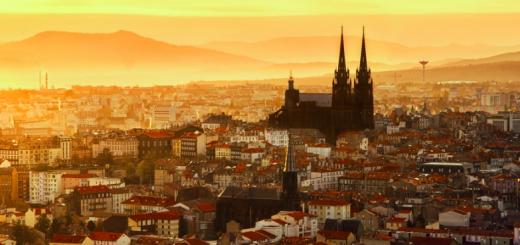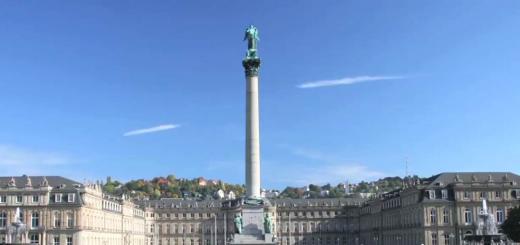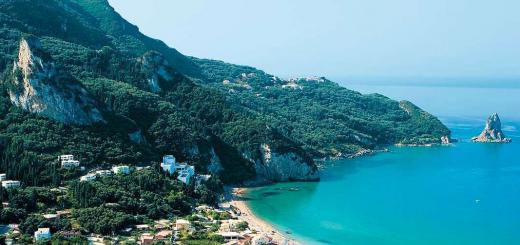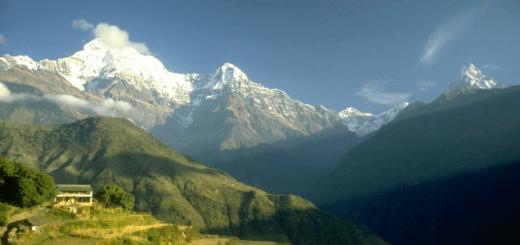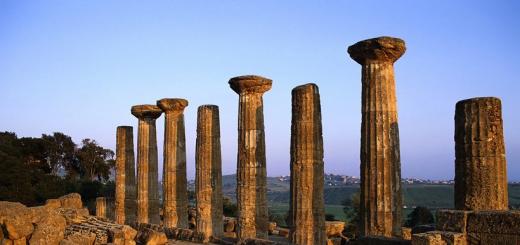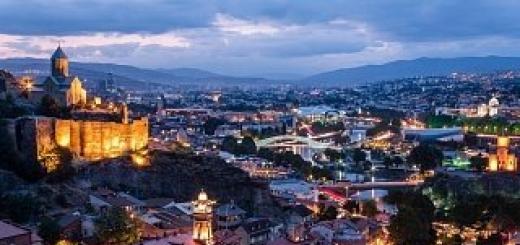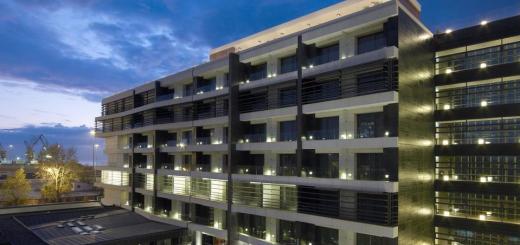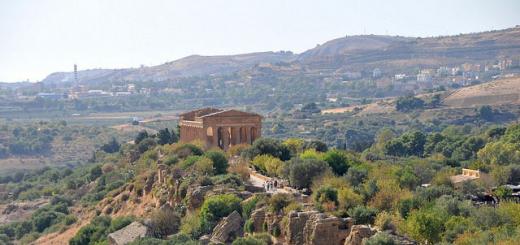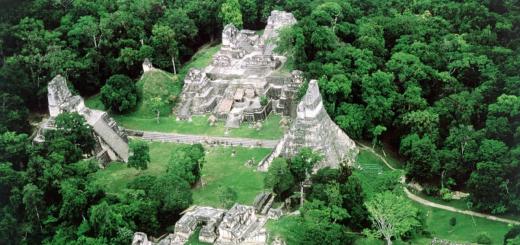To the south of the city is a row of five Greek temples, a sight worthy of comparison with the Acropolis itself in Athens. As a rule, temples are divided into two zones: the eastern zone and the western zone, on each side of the main entrance and the road from the city center. Sometimes it gets unbearably hot in summer, and here a little shade saves it, as well as olive trees along the ridge. Entrance costs 8 euros, an additional fee is taken for an audio tour or a simple map (data for November 2012).
The first temple to the east of the entrance is the Temple of Hercules (Italian Tempio di Ercole) - long, thin and only a third preserved. This is the oldest of the temples, built around the end of the 6th century BC. e. Of particular interest are the tracks left near it from ancient carts.
.jpg)
The path continues behind small hills on the border of the mountain range - there is the Temple of Juno (Italian: Tempio di Giunone). Partially destroyed, it gives an excellent view of the ridge below, leading to other temples.
To the west of the main entrance is the massive Temple of Jupiter (Italian: Tempio di Giove), which was never completed, and now its construction can only be seen with great difficulty. The most notable is one of the huge stone statues, now lying on the ground.
Behind it is a small, ruined Temple of the Dioscuri (Italian: Tempio di Dioscure).
Behind the small temple is a small but interesting Tomb of Teron (Italian: Tomba di Terone).
To put everything in context, it is worth visiting the Archaeological Museum (it is located halfway to the city center), as well as the adjacent Hellenic-Roman quarter with several beautiful mosaics. Daily tours of the Valley of the Temples are run by VisitAgrigento, however an audio tour is available at the entrance to the temples. If you take appliances, you will be responsible for their safety and will be forced to return to the main entrance on your way back to return them.
To get to the Valley of the Temples by public transport, purchase a bus ticket
No. 1, 2 or 3 at the counter at the train station and take the bus in the square in front of the station.
Church of Santa Maria Dei Greci (Italian: Chiesa di Santa Maria dei Greci)

An interesting Norman church, built about a thousand years ago on the site of an ancient Greek temple. The entrance is free.
Agrigento is located in the Italian region of Sicily. The current modern city arose on the site of the ancient settlement of Akragas, founded by the Greeks in the 6th century BC.
general information
On the map of Italy, Agrigento is located in the southwestern part of the island of Sicily. The climate in the city is moderately warm. The maximum temperature in summer is +25. In winter, the temperature ranges from +10 to +15. Most of the precipitation falls during the winter months.
Important! Agrigento does not have its own airport. You can fly by plane to Catania, Palermo and Trapani.
The city can be easily reached by bus or train. From the capital of Sicily, Palermo, where the international airport is located, there are several trains a day. Agrigento can be reached from Catania, where the airport is also located.
The ancient city of Agrigento
Ticket price: From Palermo - 8…13 euros*. The duration of the trip is 2 hours. A ticket from Catania costs 15…23 euros. The duration of the trip is 6 hours.
The bus in Silicia is considered the main transport. Agrigento can be reached by bus from Palermo, Catania and Trapani.
Ticket price: from Palermo - 11 euros, travel time - 2 hours; from Trapani - from 48 euros, travel time - 5 hours; from Catania - 17 ... 24 euros, travel time - 5 hours.
In addition to the bus and train, the city can be reached by car. Coordinates on the map for motorists: SS 189 leads from Palermo to the city.
Important! Agrigento is almost all pedestrian and it is almost impossible to enter the city by car. You can find a place to park your car near the station, where there is a car park.

Valley of the Temples
Agrigento (Sicily): description of the main attractions
The main attraction of the city is the Valley of the Temples of Agrigento. It is located a few kilometers from the city center. The valley is a territory on which the remains of ancient temple buildings are located. The buildings were erected by the ancient Greeks living in this area (ancient Akragas) in the 5th-6th centuries BC. e. The archaeological park is divided into two parts by the road.
Temple of Concordia
This temple is better preserved than all the ancient buildings that have survived to this day. It is also called the Temple of Concord. This ritual building in the Doric style was erected in 430 BC. e. The temple has a quadrangular shape with columns around the perimeter.

Temple of Concordia
The columns were designed by ancient Greek architects in such a way as to create an optical illusion for those present (the structure looks much more massive and majestic than it actually is). In the 7th century BC. e. the temple became the Christian church of Saints Peter and Paul.
Temple of Hera and Juno Lacinia
This temple is located at the highest point compared to other buildings. It was erected in 450 BC. e. Previously, the building had 38 columns. Only 25 of them have survived to this day.
There is a belief that it was in this temple that a picture depicting the goddess Juno, painted by the ancient Greek painter Zeuxis, was kept.

Temple of Hera and Juno Lacinia
Temple of Hercules
Its purpose was to personify the strength and power of Hercules, revered in Sicily. Of the 38 columns, only 8 have survived to this day. The structure dates back to 510 BC. e.
Temple of Jupiter
It was built in the second half of the 4th century BC. e. It was the most majestic of all temples. It was surrounded by 38 semi-columns of 6.5 meters in circumference. The temple was supported by telamones (sculptural images of men, they were also called Atlanteans) 7.5 meters high. Only remnants of its former glory have survived to this day. The original of one of the telamones is kept in the National Archaeological Museum.
In addition to the above buildings, in the Valley of the Temples you can see the remains of temples:
- Dioscuri;
- Aesculapius;
- Ephesus or Vulcan;
- Also on the territory there are necropolises of early Christians.
Additional Information! Entrance to the territory of the Valley of the Temples is paid - 5 euros, preferential - 3 euros. Opening hours: daily from 8:30 to 19:00.
Agrigento itself in Sicily is also of interest to tourists: it has preserved medieval buildings, and there are also many churches, museums, squares and alleys. In the city itself, the following attractions are of interest:
- Cathedral. The building of the cathedral, together with the bell tower, remained unfinished. The building has excellent acoustics. Inside you can admire the beautiful paintings. It was erected in the middle of the 15th century.
- Bishop's Palace and Seminary (14th century), as well as the building of the Lukesian Library. All these buildings are located opposite the Cathedral.
- Church of Santa Maria dei Greci. Its building was erected on the ruins of an ancient temple of Athena.
- Theater Luigi Pirangelo (18th century).
- City Museum, located in Piazza Pirandello. The City Hall is also located there. Address: Cortile St Spirito, I-92100 Agrigento.
- Diocesan Museum.
- Churches of Saint Lawrence, Holy Spirit, San Biagio.
- Sanctuary of Demeter and Persephone.
- Archaeological Museum (considered the largest and most visited museum).

Temple of Jupiter
Tours
To better know the history of all the sights of Agrigento, you should book a tour of the iconic places of the city. The cost of excursions starts from 200 euros. In addition to excursions around the city itself, you can book a tour of other provinces of Sicily and look at local attractions.
Types of recreation
Agrigento is famous for its beaches. The best time to relax on them is summer - mid-autumn. There are no beaches in the city itself, but the road to the suburban ones will take no more than 15 ... 20 minutes.
- San Leone beach. It is located near the main attraction of the city - the Valley of the Temples. During the high season, the beach is filled with tourists.
- Scala dei Turki. Here is the most beautiful nature, sandy shore and very warm sea water, which is suitable for relaxing with a child.
- You can also note such beaches as Kaos, Marinella, Lido Azzuro.
In addition to relaxing on the beaches, you can walk along the streets of the city and try to feel the spirit of the Middle Ages - here it will not be difficult. True, the view of the city itself creates a feeling of dilapidation, but this does not hurt to take great photos that convey the mood of Agrigento.
A few kilometers from Agrigento is San Leone - a tourist place by the sea. You can go here after all the interesting places in Agrigento have been explored. There are amusement parks for adults and children. You can also go on a boat trip from here.

San Leone beach
You can arrange a gastronomic tour of Agrigento. The city is famous for its cuisine, however, like any other city in Italy. Definitely worth a try:
- pasta with sardines;
- various types of mussels, fried fish;
- local delicacy - marinated shrimps;
- Kubaita's signature dessert is a confection made with sweet honey and roasted almonds.
Information for tourists
Going on an excursion to the Valley of the Temples in the summer, you should definitely take a minimum supply of drinking water and a hat with you.
There are few hotels in the city, but you can choose an option and find both a 5-star hotel and a 3-star hotel.
On a note! In February, hundreds of almond trees bloom in the Valley of the Temples, which gives the place a special beauty.
The direction of Agrigento Sicily can rightly be called one of the most interesting. This city is definitely worth a visit. It contains everything in order to get vivid impressions, a sea of emotions and wonderful memories of what you saw.
*The prices indicated in the article are current at the time of publication of the material.
This largest Italian island is well known to travelers from all over the world due to the abundance of sun, magnificent nature, clear waters of warm seas, and many unique natural, historical and architectural monuments.
Sicily wonderfully combines the hustle and bustle of the city streets and calm beaches, the mafia and friendly cordial and hospitable citizens. It seems that it is woven from contradictions. Greeks, Arabs, Spaniards left many outstanding monuments here, which are a must-see for guests of the country.
Where is Sicily located?
The island of Sicily is located south of the mainland of Italy, between Europe and Africa. In the north, it is adjacent to the Apennine Peninsula. To the south of the island is Malta. A little further south are Tunisia and Egypt. In the northwest direction is another island of Italy - Sardinia. Sicily's eastern neighbor is Greece, from which the island is separated by the Ionian Sea. In addition, Sicily is washed by the Tyrrhenian (in the north) and the Mediterranean (in the south and west) seas. For lovers of exact numbers, we inform you that the geographical coordinates of Sicily are 37 ° 45’ 0 "N and 14 ° 15’ 0" E. d.
A bit of history
Today we invite you to take a short virtual tour of one of the ancient cities of Sicily - Agrigento, but first let's get acquainted with some historical facts.
In different periods of its history, this city had different names. The ancient Greeks called it Akragas, the Romans, who built their mighty empire, renamed it Agrigenta. Centuries later, the Arabs called it Kerkent Germente. The name Girgenti was given to the city by the Norman rulers. The current name was officially adopted in the middle of the 20th century, when the fascist regime ruled in Sicily.
The first mention of a settlement located on the lands where the city of Agrigento in Sicily is now located dates back to the 6th century BC. During this period, Rhodes and Cretan navigators mastered the local shores and founded the city of Akragas on the island. It soon became an important Greek colony, on a par with Syracuse to the south.

A few decades later, the city occupied an area of five hundred hectares. Residential and administrative buildings were surrounded by strong walls, which initially had nine gates. It was a fairly large city for its time. Akragas was inhabited by more than three hundred thousand inhabitants. They included citizens of other colonies and Greek metropolises, and descendants of the first colonists, as well as slaves.
Historians consider the heyday of the city to be the 5th century BC. e., when they were ruled by the mighty Theron. He managed to constantly expand the zone of influence of the city. The Temple of Zeus built by the Greeks, which was surrounded by other religious buildings, can be considered a real breakthrough for the architects of that time. Some of these buildings have survived in the Valley of the Temples to this day.
When the Western Roman Empire fell, the Byzantines and then the Norman conquerors came to power in Agrigento in Sicily. The city was later taken over by the Spaniards. And only in 1860 the city became part of Italy. Agrigento on the island of Sicily received its current name in the late twenties of the XX century.
Today, little remains of the former greatness of a large and important administrative center. The area of the city and its environs is only about 250 sq. km. The population is about 55.5 thousand inhabitants.
Getting to know modern Agrigento: city streets
The city perfectly conveys the spirit of the Middle Ages - narrow streets covered with paving stones, ancient architecture, exquisite fountains. Agrigento (Sicily) is especially good at sunset, the play of shadows turns it into a kind of theatrical scenery for the play of the great master.

Architecture
Despite its turbulent history, Agrigento (Sicily) has preserved numerous ancient monuments that are of interest to tourists. These are fortifications, and medieval palaces, and several museums, cathedrals, churches and monasteries, large squares and miniature courtyards that keep the memory of ordinary people and nobles who lived in this city hundreds of years ago. The city has preserved the heritage of dozens of cultures and absorbed all the best of them.
Sicily, Agrigento: holidays
One of the most popular and most visited resorts in the province of Agrigento is undoubtedly Schiaccia. This is a fairly large city, it is famous for its thermal springs and luxurious white beaches, among which it is necessary to highlight the areas of Tonnara, Stazzone, San Marco and Foggia. All these amazing places are ideal for a beach holiday and a relaxing time. Unique landscapes, warm and clear waters of the Mediterranean Sea and comfortable hotels - all this attracts tourists to the resorts of Agrigento (Sicily).

Island holidays are very popular in the province of Agrigento. The Pelagian Islands hospitably open their arms to everyone who wants to sunbathe under the gentle sun.
The beaches of Agrigento
According to experienced travelers, here are the best beaches in Sicily. Agrigento, thanks to its climatic conditions, allows you to enjoy a beach holiday throughout the year. However, the best time to visit the city is early summer or early autumn. First of all, we recommend that you visit the San Leone beach, which is known to everyone who has been to the island. It is located near the famous Valley of the Temples, where the main historical monuments of ancient Greek architecture are concentrated. The sea here is calm, however, there are quite a lot of tourists in the high season.

Be sure to visit the Scala dei Turki beach. Once upon a time, Turkish pirates lived here, thanks to which the beach got its name. This is a great place for a relaxing family holiday. Magnificent nature, comfortable climatic conditions and warm sea water.

What to see in Agrigento?
When visiting this city for the first time, we recommend visiting its historical center. It is here that the main attractions of Agrigento (Sicily) are concentrated - monuments of architecture and art that illustrate the history of this ancient place.
Unfortunately, there is not much left of the former grandeur of the Old Town, but tourists with great pleasure roam the old streets and visit places where the spirit of antiquity hovers. The city has several beautiful temples, monumental palaces, spacious squares and shady alleys. In Agrigento (Sicily), the photo of which we posted in this review, will certainly appeal to everyone who loves the unique fabulous beauty of small old towns.
Museums
Probably, it is necessary to dwell in more detail on the museum complex of the city, since it is visiting museums that allows you to better know the history, culture, and traditions of an unfamiliar place. The largest and most visited is the Archaeological Museum.

You should definitely visit the Civico Museum, where a large number of paintings and sculptures that have come down to us from the Middle Ages are collected in huge galleries.
In 1963, the Diocesan Museum began its work in the city, built according to the project of the architect Minissi. Here are the relics of the nearby Cathedral and the seminary adjacent to it, as well as exhibits that testify to the history of the local church, rites and traditions.
There is another unique institution in Agrigento (Sicily). This is a gem museum. Here you can not only enjoy the beauty of precious stones, but also learn to distinguish between natural and artificial minerals, feel like a real gemologist, and work on professional equipment.
Valley of the Temples
Undoubtedly, this is the main attraction of Agrigento (Sicily). A huge temple complex that amazes and fascinates with its scale and unsurpassed splendor. Hundreds of thousands of tourists come here from different parts of our planet to take a look at the ancient buildings and temples with their own eyes, which, despite the past centuries, are perfectly preserved.
To get here, you need to go to the southeastern region of the city. You will find yourself surrounded by monuments that symbolize the former greatness of the Greek colony. The first temples on this land were built in the 5th century BC. e.

Temple of Zeus
Initially, it was planned to build a structure measuring 56 x 112 meters with twenty-meter columns. The temple was supposed to be the largest Doric building of the ancient Greeks. But the storming of the city by the warriors of Carthage did not allow the construction to be completed, and a strong earthquake practically destroyed what had been built by that time. Today, in the midst of the ruins, there is an 8-meter sculpture of King Telamon, who raised his hands to the sky.
The temple was built in the 11th century. It was seriously damaged by a landslide (1244), but was reconstructed. In the 17th century it was rebuilt in the Baroque style. The south side of the temple is decorated with double Norman windows, and in the western part of the building there is an episcopal seminary. Steps from the majestic bell tower lead to the main entrance to the cathedral. The three-aisled basilica, which was restored after the devastating earthquake of 1966, adorns the interiors.

The nave has been preserved, the front part of the building is made in the Gothic style, the wooden ceiling was decorated in the 17th century.
Sanctuary of Kalogera
A unique building in Agrigento (Sicily) was built between the 13th and 14th centuries. It is divided into three parts by two colonnades. A rectangular apse with three chapels crowns its center. The altar was made in the 14th century from wood with mother-of-pearl inlays. The building is decorated with gilded multi-colored mosaics, the work of Michele Amico.

Where to stay in Agrigento (Sicily)?
The city can be divided into three districts:
- the historical center, which is located on the top of the hill;
- lower part, at its foot;
- the main street is via Atenea.
You can choose hotels in Agrigento (Sicily), located in the valley. They offer stunning views of the orange orchards and the Valley of the Temples.
Among the hotels in the historical part of the city, we should highlight the small but very cozy B&B Bibirria. It offers accommodation in only four rooms. Each has a dining area, kitchen, bathroom and bedroom. The rooms are equipped with air conditioners, necessary household appliances.

You can pay attention to another hotel in the historical part of the city - B&B Liol, which is located next to the Cathedral. It is also quite small (three apartments) with a shared kitchen with a refrigerator that stores snacks. In the morning, the hotel serves a rich and tasty breakfast, which can be served in your room.
Most of the shops, restaurants and bars are located in the lower part of the city. Several hotels located in the area overlook the Valley of the Temples. B&B Portatenea, for example, is located right on the main street (via Atenea), with public parking next to it. Breakfast at this hotel is served on the terraces.
The nearby B&B Marchese Sala is a real palace built in the 18th century. From its terrace and from the windows of the rooms there is an amazing view of the Mediterranean Sea and the Valley of the Temples. The owners of the hotel organize and conduct excursions.
B&B Villa San Marco is located 500 meters from the temples and is also surrounded by a beautiful garden where birds chirp merrily. At any time of the day you can cool off in the swimming pool located on site.
Hotel Villa Athena is the most luxurious hotel in Agrigento (Sicily). It is located in a villa built in the 18th century. In 2012, the hotel was recognized as the best on the island. Some of its rooms overlook a wonderful garden, some - the Valley of the Temples. Each room has its own bathroom, finished with natural marble, bedroom and living room, furnished in a classic style.

What travelers say
About Agrigento (Sicily) reviews of tourists are different. For the most part, vacationers are satisfied with the trip. They liked the wonderful nature and climate of Sicily. Agrigento attracts with a calm, measured way of life, an excellent opportunity to combine a beach holiday with an excursion.
Someone thinks that Agrigento in Sicily is suitable for lovers of history and ancient architecture. There is little entertainment in the city, so many go to clubs and discos located in the nearest resorts.
The total area of the monument is about 1300 hectares. In the VI century. BC. Greek settlers founded the colony of Akragas here, which was conquered by the Carthaginians two centuries later. Witnesses of the rich history of the city are Doric temples, squares, pagan and Christian burials, as well as a dense water supply network.
Valley from a bird's eye view
Scientists have identified in the valley the ruins of as many as ten temples of the Doric order and three sanctuaries, as well as many burials, fragments of the fortification system and part of the ancient Roman quarter, built on the site of the ancient Greek. There were also two market squares where meetings were held (in Greek they were called "agora"), and an administrative building for meetings of the city council - the bouleuterium.
temples

Temple of the Dioscuri. Photo © Merlijn Hoek, Angelo Milioto / Flickr.com
The temple of the mythical Dioscuri twins Castor and Pollux, the sons of Jupiter (Zeus) and the wife of the Spartan king Leda, has become a symbol of Agrigento.

Temple of Concordia. Photo / Shutterstock.com
The temple of the goddess of consent Concordia stands on the sacred road; it was built around the 5th century. BC. and is distinguished by the best preservation among the entire complex. In the VI century. AD a Christian church was set up in it. The original purpose of the temple was identified by an inscription found near the building.


Temple of Concordia. Photo © mariocutroneo, Merlijn Hoek / Flickr.com
The temple of Jupiter (Zeus) was built in gratitude for the victory of the inhabitants of Akragas over the Carthaginians in 480 BC. A gigantic figure of an atlas, consisting of massive stone blocks, has been preserved here.



Temple of Zeus. Photo © Dennis Jarvis, Terry Feuerborn / Flickr.com
Temple of Hercules (Hercules)
Temple of Hercules (Hercules) - the most ancient in the valley; the cult of the legendary hero was one of the central ones in Akragas. The building contained a bronze statue of Hercules; the temple was destroyed by an earthquake, and today only eight columns remain from it.



Temple of Hercules. Photo © poudou99 / Wikimedia Commons
Temple of Juno Lacinia
The temple of Juno Lacinia (scientists find it difficult to establish with accuracy who the temple is dedicated to, therefore the name is conditional) stands on a spectacular cliff, on the eastern part of the hill. On the walls of the cella (interior, limit), traces of a fire are still clearly visible: in 406 BC. this temple, almost indistinguishable from that of Concordia, was destroyed by the Carthaginians. Near the ruins of the temple, you can see a large altar for sacrifices (on the east side) and a section of the road with deep tracks from the wheels of carts passing along it.


Temple of Juno Lacinia. Photo © Angelo Milioto, mariocutroneo / Flickr.com
The temple of the god of healing Aesculapius was built quite far from the walls of the ancient city: the sick flocked here, praying for recovery. The walls of the temple were covered with inscriptions of gratitude from those who were lucky enough to be cured.
The Temple of Vulcan (Hephaestus) was built in the 5th century. BC. and, apparently, had a rather impressive scale. Unfortunately, very little of it remains today. In the foundation, the ruins of an even more ancient and very small temple were revealed.
Near the Golden Gate is the so-called "Tomb of Theron". It has nothing to do with the ruler of Acragas Theron: in fact, this pyramidal building made of tuff is a monument to those who died in the Second Punic War (Rome against Carthage, 218-201 BC).
Acropolis and Burials

Agora. Photo © Harvey Barrison / Flickr.com
The agora, the market square, which served as the main center of social life of the Greek city-states, also makes a great impression. In addition, it is worth seeing the "Council Hall" north of San Nicola Hill and the gymnasiums - a place where the townspeople played sports, studied and spent their leisure time.


Byzantine and early Christian burials. Photo © Clemensfranz / Wikimedia Commons, © Dennis Jarvis / Flickr.com
There are many Greek, Roman and early Christian necropolises in the valley, located just outside the ancient city. Also noteworthy are the plumbing, floor mosaics from Greek and Roman residential areas, as well as early Christian basilicas of the later era - for example, not far from the Temple of Concordia.

